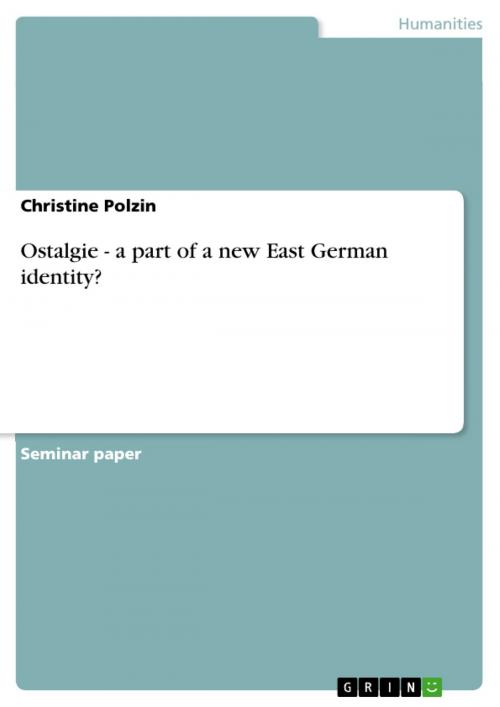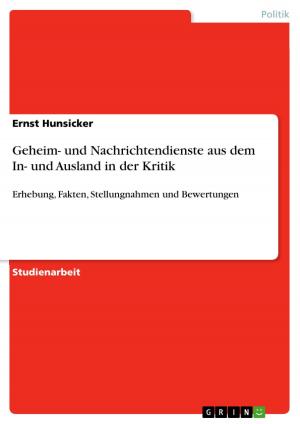Ostalgie - a part of a new East German identity?
a part of a new East German identity?
Nonfiction, Social & Cultural Studies, Social Science, Anthropology| Author: | Christine Polzin | ISBN: | 9783638491587 |
| Publisher: | GRIN Verlag | Publication: | April 15, 2006 |
| Imprint: | GRIN Verlag | Language: | English |
| Author: | Christine Polzin |
| ISBN: | 9783638491587 |
| Publisher: | GRIN Verlag |
| Publication: | April 15, 2006 |
| Imprint: | GRIN Verlag |
| Language: | English |
Seminar paper from the year 2003 in the subject Ethnology / Cultural Anthropology, grade: 1,0, European University Viadrina Frankfurt (Oder), course: Seminar: MA, Soziale Bewegungen-Institutionen-Kulturelle Orientierungen, 13 entries in the bibliography, language: English, abstract: East Germans and their search for identity in a re-unified Germany has become a topic of intense debate among academics, the media and within the East German community itself. Only a few years after the initial euphoria of reunification had worn off, and the dream to become 'ein Volk' had (at least constitutionally) been fulfilled, Easterners began searching for a distinct identity. Part of this contested identity has expressed itself in the phenomenon of Ostalgie - the revival of products and symbols of the German Democratic Republic (GDR). This essay analyses ostalgic practices in the context of the specific east German situation after reunification, a period which was not only characterized by the forces of liberation and progress which are so often portrayed in the media and official discourse, but also by experiences of severe rupture and losses in many parts of everyday life. What is the meaning and purpose of Ostalgie? Why did East Germans start emphasising their distinct Ostidentität (eastern identity) and why did it emerge in the first place? Is it part of a natural, long-term development rooted in the communist social doctrine, i.e. a form of nostalgia and GDR transfiguration? Or is it an after-effect of the asymmetric transformation, i.e. an act of defiance, resulting from disappointment? This essay attempts to answer these questions and support the hypothesis that it is neither nor. We argue that Ostalgie partly serves as a peaceful self-upgrading and self-conserving strategy to cope with the strains and challenges of transformation. Thus, Ostidentität is more than a cyclical trend, reflecting a romanticised transfiguration of the past GDR era. To a large extent, its constituent elements emerged in reaction to the unexpectedly Western-dominated process of East Germany's social, economic and cultural development. As long as this process remains asymmetrical and driven largely by West German actors, a specific East German identity will continue to exist and possibly develop further, at least in the minds of those who still have personal memories of the GDR.
Seminar paper from the year 2003 in the subject Ethnology / Cultural Anthropology, grade: 1,0, European University Viadrina Frankfurt (Oder), course: Seminar: MA, Soziale Bewegungen-Institutionen-Kulturelle Orientierungen, 13 entries in the bibliography, language: English, abstract: East Germans and their search for identity in a re-unified Germany has become a topic of intense debate among academics, the media and within the East German community itself. Only a few years after the initial euphoria of reunification had worn off, and the dream to become 'ein Volk' had (at least constitutionally) been fulfilled, Easterners began searching for a distinct identity. Part of this contested identity has expressed itself in the phenomenon of Ostalgie - the revival of products and symbols of the German Democratic Republic (GDR). This essay analyses ostalgic practices in the context of the specific east German situation after reunification, a period which was not only characterized by the forces of liberation and progress which are so often portrayed in the media and official discourse, but also by experiences of severe rupture and losses in many parts of everyday life. What is the meaning and purpose of Ostalgie? Why did East Germans start emphasising their distinct Ostidentität (eastern identity) and why did it emerge in the first place? Is it part of a natural, long-term development rooted in the communist social doctrine, i.e. a form of nostalgia and GDR transfiguration? Or is it an after-effect of the asymmetric transformation, i.e. an act of defiance, resulting from disappointment? This essay attempts to answer these questions and support the hypothesis that it is neither nor. We argue that Ostalgie partly serves as a peaceful self-upgrading and self-conserving strategy to cope with the strains and challenges of transformation. Thus, Ostidentität is more than a cyclical trend, reflecting a romanticised transfiguration of the past GDR era. To a large extent, its constituent elements emerged in reaction to the unexpectedly Western-dominated process of East Germany's social, economic and cultural development. As long as this process remains asymmetrical and driven largely by West German actors, a specific East German identity will continue to exist and possibly develop further, at least in the minds of those who still have personal memories of the GDR.















